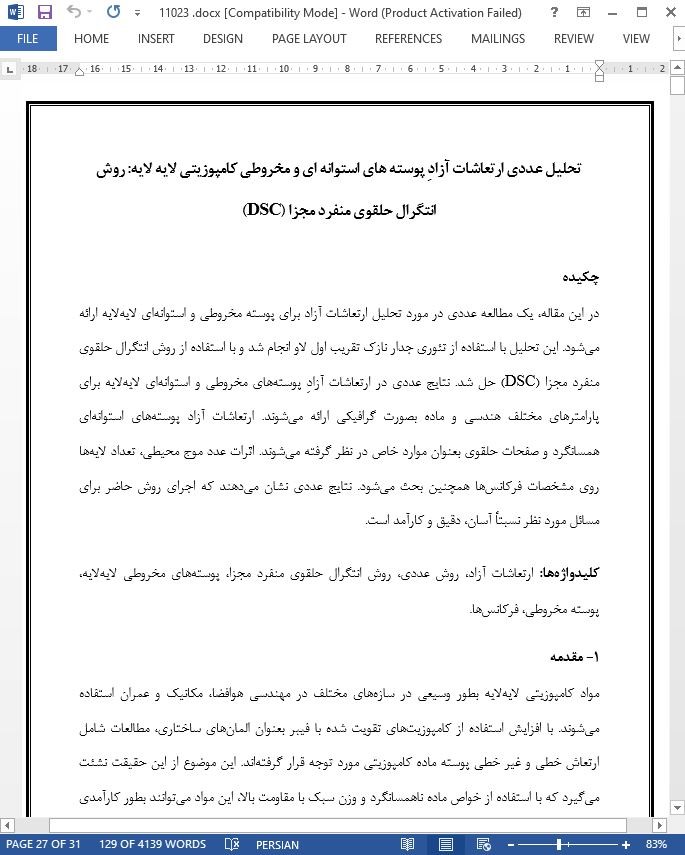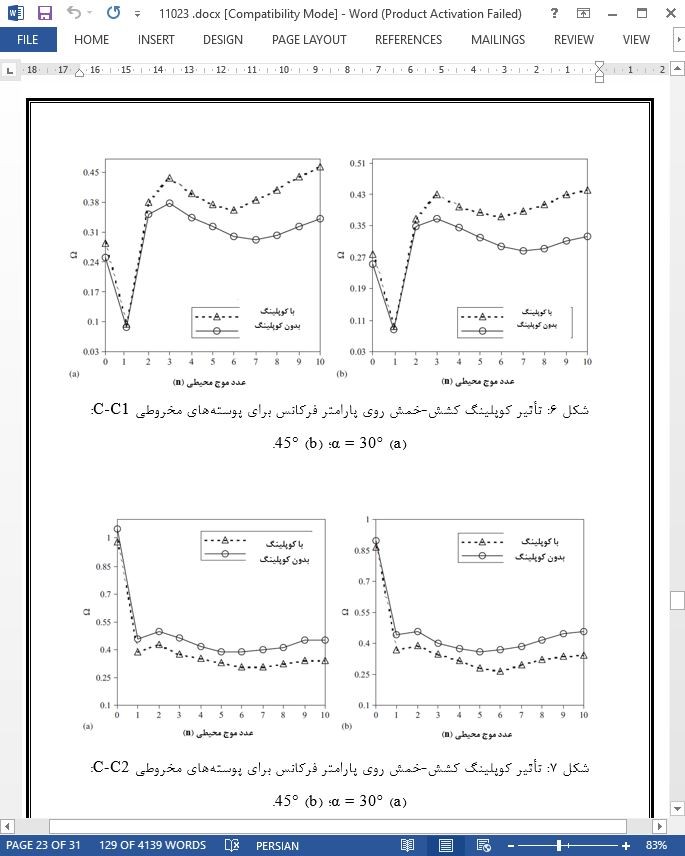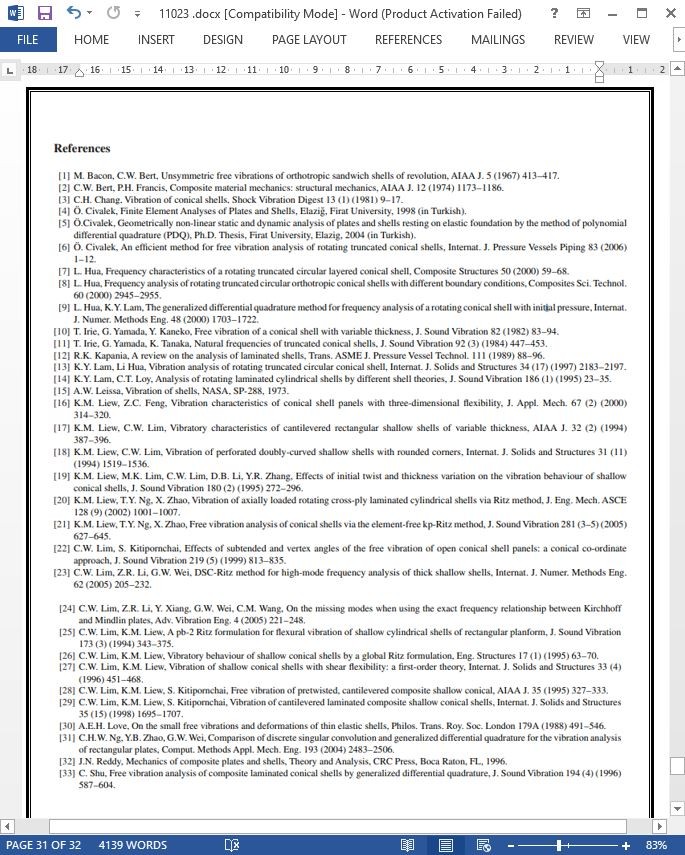
تحلیل عددی ارتعاشات آزادِ پوسته های استوانه ای و مخروطی کامپوزیتی لایه لایه
چکیده
در این مقاله، یک مطالعه عددی در مورد تحلیل ارتعاشات آزاد برای پوسته مخروطی و استوانهای لایهلایه ارائه میشود. این تحلیل با استفاده از تئوری جدار نازک تقریب اول لاو انجام شد و با استفاده از روش انتگرال حلقوی منفرد مجزا (DSC) حل شد. نتایج عددی در ارتعاشات آزادِ پوستههای مخروطی و استوانهای لایهلایه برای پارامترهای مختلف هندسی و ماده بصورت گرافیکی ارائه میشوند. ارتعاشات آزاد پوستههای استوانهای همسانگرد و صفحات حلقوی بعنوان موارد خاص در نظر گرفته میشوند. اثرات عدد موج محیطی، تعداد لایهها روی مشخصات فرکانسها همچنین بحث میشود. نتایج عددی نشان میدهند که اجرای روش حاضر برای مسائل مورد نظر نسبتاً آسان، دقیق و کارآمد است.
1- مقدمه
مواد کامپوزیتی لایهلایه بطور وسیعی در سازههای مختلف در مهندسی هوافضا، مکانیک و عمران استفاده میشوند. با افزایش استفاده از کامپوزیتهای تقویت شده با فیبر بعنوان المانهای ساختاری، مطالعات شامل ارتعاش خطی و غیر خطی پوسته ماده کامپوزیتی مورد توجه قرار گرفتهاند. این موضوع از این حقیقت نشئت میگیرد که با استفاده از خواص ماده ناهمسانگرد و وزن سبک با مقاومت بالا، این مواد میتوانند بطور کارآمدی مورد استفاده قرار گیرند [2،32]. بخاطر اهمیت عملی تحلیل ارتعاش آزادِ پوسته مخروطی لایهلایه کامپوزیتی در کاربردهای ساختمانی، هوافضا، هستهای، پتروشیمی، بدنههای زیردریایی و کاربردهای مکانیکی، تعداد اندکی از محققان بمنظور بررسی تحلیل ارتعاش آزاد این نوع از سازهها، مطالعاتی را انجام دادهاند. روشهای مختلفی برای تحلیل ارتعاشات آزاد پوسته مخروطی از قبیل روش المان محدود، روش ریتز، روش گالرکین، روشهای دیگر تقریب عددی و روی تربیع دیفرانسیلی مورد استفاده قرار گرفته است. ارتعاش آزاد نامتقارن پوستههای ساندویچی ارتوتروپیک از چرخش توسط بیکن و بِرت [1] انجام شده است.
5- نتیجهگیریها
حل عددی معادلات دیفرانسیلی جزئی، نقشی قابل ملاحظه در حوزههای مهندسی ایفا میکند. بنابراین، یک تکنیک عددی مؤثر برای حل معادلات جزئی، بسیار مطلوب است. در جستجو برای یک روش عددی مؤثرتر که به نقاط شبکه کمتری نیاز دارد اما دقت قابل قبولی را بدست میآورد، روشِ DSC توسط وِی [43] معرفی شد.
کار ارائه شده در اینجا در رابطه با استفاده از روش DSC برای تحلیل ارتعاش پوستههای مخروطی و استوانهای لایهلایه است. نتایج با راهحلهای موجودِ دارای عملکرد عالی مقایسه شدند. مشخص شد که همگرایی روش DSC بسیار خوب است و نتایج بخوبی با نتایج بدست آمده بوسیلهی محققان دیگر موافقت دارد. در نتیجه، روش DSC یک ابزار دقیق و کارآمد را برای حل مسائل مربوط به پوستههای مخروطی و استوانهای لایهلایه ارتروتروپیک ارائه میدهد.
Abstract
A numerical study on the free vibration analysis for laminated conical and cylindrical shell is presented. The analysis is carried out using Love's first approximation thin shell theory and solved using discrete singular convolution (DSC) method. Numerical results in free vibrations of laminated conical and cylindrical shells are presented graphically for different geometric and material parameters. Free vibrations of isotropic cylindrical shells and annular plates are treated as special cases. The effects of circumferential wave number, number of layers on frequencies characteristics are also discussed. The numerical results show that the present method is quite easy to implement, accurate and efficient for the problems considered.
1. Introduction
Laminated composite materials are increasingly used in aerospace, mechanical and civil engineering structures. With the increasing use of fiber-reinforced composites as structural elements, studies including the linear and nonlinear vibration of composite material shell are receiving considerable attention. This arises from the fact that, by taking advantage of its anisotropic material properties and light weight with high strength, the materials can be used very efficiently [2,32]. Because of the practical importance of the free vibration analysis of the composite laminated conical shell in structural, aerospace, nuclear, petrochemical, submarine hulls, and mechanical applications, a few investigators have made efforts to deal with free vibration analysis of this type of structures. Various methods for analyzing free vibrations of the conical shell such as the finite element method, Ritz method, Galerkin method, the other numerical approximate methods and the differential quadrature method have been tried. Unsymmetric free vibration of orthotropic sandwich shells of revolution has been made by Bacon and Bert [1].
5. Conclusions
The numerical solution of partial differential equations plays a considerable role in the areas of engineering. Therefore, an effective numerical technique for the solution of partial equations is very desirable. In seeking a more efficient numerical method that requires fewer grid points yet achieves acceptable accuracy, the method of DSC was introduced by Wei [43].
The work presented here concerns the use of DSC method for the vibration analysis of laminated conical and cylindrical shells. Results were compared with existing solutions showing excellent performance. It is found that the convergence of DSC approach is very good and the results agree well with those obtained by other researchers. Thus, the DSC method provides an accurate, efficient means of solving problems for orthotropic laminated conical and cylindrical shells.
چکیده
1- مقدمه
2- معادلات حاکم
3- الگوریتم حلقوی منفرد مجزا (DSC)
1-3- کرنل دلتای شانون تنظیم شده (RSDK)
4- کاربردهای عددی
1-4- نتایج عددی برای صفحات حلقوی (α = π/2)
2-4- نتایج عددی برای پوستههای استوانهای همسانگرد
3-4- نتایج عددی برای پوستههای مخروطی همسانگرد
4-4- نتایج عددی برای پوستههای استوانهای لایهلایه
5-4- نتایج عددی برای پوستههای مخروطی لایهلایه ارتوروپیک
5- نتیجهگیریها
Abstract
1. Introduction
2. Governing equations
3. Discrete singular convolution (DSC)
3.1. Regularized Shannon’s delta kernel (RSDK)
4. Numerical applications
4.1. Numerical results for annular plates ( = /2)
4.2. Numerical results for isotropic cylindrical shells
4.3. Numerical results for isotopic conical shells
4.4. Numerical results for laminated cylindrical shells
4.5. Numerical results for orthotropic laminated conical shells
5. Conclusions
- ترجمه فارسی مقاله با فرمت ورد (word) با قابلیت ویرایش، بدون آرم سایت ای ترجمه
- ترجمه فارسی مقاله با فرمت pdf، بدون آرم سایت ای ترجمه



